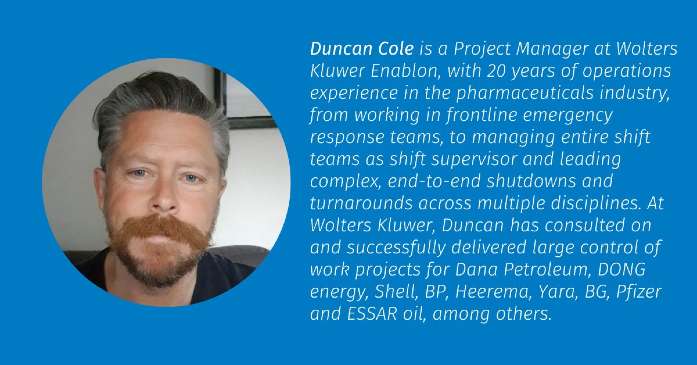As national governments start to deliver new COVID-19 vaccines to the public, the topic of drug product integrity has become a central topic of popular discussion. Specifically, how do pharmaceutical companies maintain the safety of their products for treating the most vulnerable patients?
I recently spoke with Duncan Cole, Project Manager at Wolters Kluwer Enablon, about Good Manufacturing Practices (GMP), which are the minimum industry standards that a drug manufacturer must meet in their production processes. Duncan has 20 years of production experience at Novartis.
Here are Duncan’s answers to five questions over GMP and the importance of product traceability in pharmaceutical production.
Back in your industry days, you led your team’s efforts to reduce plant downtime for changeovers, why was reducing downtime so vital?
Duncan: The most important thing to remember here is the impact to the patient who, through no fault of their own, is not getting their supply of tablets because there has been a longer than expected changeover for example. It was imperative that we minimize the time taken moving from one product to another. This was also driven due to moving to a much smaller safety stock. The days of having a warehouse full of product was long gone and we needed to ensure we could supply the product in a much more efficient way, and this meant we needed to carry out a LEAN exercise of our changeover process.
We “LEAN’d” the whole process, we actually did this because we could see that we had lots of gaps. An example of this would be how long a task would take a member of the team compared to another member. This could be down to experience but needed to be addressed to give a much more robust and realistic time for a task.
So, to LEAN and take out all the waste was the first point. That and improved cleaning methods and procedures enabled us to reduce one changer cycle from 6 to 2.5 weeks.

What can lead to contamination during a changeover or maintenance activity? Can you give an example and what impact this could have to the patient? How does GMP come into play?
Duncan: Imagine if you were taking a manway off a reactor, for instance. You’ve got to check your surroundings. It might be that it is dusty and a source of contaminants. It might be that there’s paint, we actually did a whole project removing all paint from manways. It was the case that the top of the reactors and their manways were painted which once upon a time was acceptable but tighter regulations meant this was outdated.
Imagine when you’re opening up a manway, that paint will possibly flake off and where does it end up? Does it end up outside of the reactor? Or can it drop into the reactor? You would be amazed when you’re cleaning up a plant, what kinds of things you can find and how important it is to recognize contamination can and does happen – the idea was to reduce that risk to next to nothing.
Remember too, early stages of producing a batch of – whatever it may be – may not be as stringent. As we get closer to the later, post-filtration phases, closer to the end, there is less chance of contamination being captured.
With the introduction of GMP permits or certificates, a more robust process was introduced which ensured a number of steps were followed to ensure that all potential actions had been taken to avoid any contamination. Examples of these would be to check that the number of tools taken into an area for maintenance were the same number taken out, the PPE worn was intact upon completion of the work. If the answer to those questions were ‘no’, then actions needed to be taken as to why the tools returned were less, were they in the reactor? Was the piece of PPE in the reactor?
It’s just the possibility of contaminating a batch – can you imagine if something did get through? Something that could actually end up in a tablet and given to a patient causing an adverse effect? Or dying, the extreme.
If the worst were to happen then it is important to remember that traceability is key. Any investigation needs to be able to go all the way back through the whole process figuring out what the contaminant was and how it could have entered the product stream in the first place. Production may need to stop whilst the investigation is taking place, it may mean that the whole plant needs to be cleaned out before restarting the process and all this can be time consuming, expensive and most importantly, lead to a potential stock out of product meaning the patient not receiving vital medication. Remember too that whole batches may need to be incinerated if they cannot be re-worked (cleaned) and this comes at a cost!
As mentioned too, if the worse was to happen to a patient, then the impact on the reputation of the company is huge.
Management systems have changed so much between then and now. If you could have done it differently, knowing what you know now, what would have you changed?
Duncan: The team that we had was a very good team, very experienced. When I left Novartis, we had created a much more streamlined way of working, the detail of the documentation had improved significantly, the planning was better and sometimes we were planning up to a year in advance.
Can you imagine what that’s like with a paper system? We had files and files of work that needed to be prepared in advance, if we had had an electronic permit-to-work system, and if we had everything drafted and ready to go before the work needed to take place, it would have improved things even further. Today, a lot of our Enablon clients want a reporting tool to see when a person created a work permit, took the permit live, did the work, and then closed it out, and the length of time to do that all. I had to do that manually.
Why is it so important to have a visual overview of all of your work?
Duncan: It gives everybody visibility. If you’re doing a break-in, you could see who is working nearby, who is working above you for instance because some of these buildings are four levels and some of it is open grating. It could be that somebody is actually working above you and breaking into a methanol line just as you are beginning a hotwork task, the two do not mix well!
One of the many benefits of permit-to-work is the visualization, whatever you can see during your morning meetings helps you know who is working where and on what.
We’re in the early days with pharmaceuticals; I think there is always somewhere where we can improve upon with the technology, and GMP is certainly something we can start with, as it is such a key factor for all of pharma.
This is the first Q&A post in a four-part series with Duncan Cole, Project Manager at Wolters Kluwer Enablon. Keep following our blog for the other three posts.





